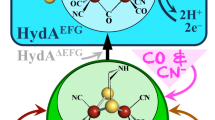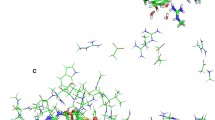Abstract
In the last years, H2S has been recognized as a signaling molecule in mammals, which can synthesize and catabolize (by oxidation) such species. The latter process is accelerated by a sulfide:quinone oxidoreductase (SQR, E.C. 1.8.5.4), a flavin-dependent sulfide oxidase (FDSO). FDSOs catalyze electron transfer from H2S to an acceptor in catalytic cycles involving two phases: (I) reduction of FAD by H2S (SH−) and (II) electron transfer from FADH− to the electron acceptor. The first step of FAD reduction consists on the reaction of SH− with a catalytic disulfide at the active site of the enzyme, to yield a thiolate and a persulfide in the protein. This step is ca. 106 times faster than the analogous reaction with low-molecular-weight disulfides (LMWDs) and the causes of such extraordinary acceleration remain unknown. Using the IEF-PCM(ε ≈ 10)/M06-2X-D3/6-31+G(d,p) level of theory, we have modeled the reaction of SH− with a disulfide as located in a representative model of the active site extracted from a prokaryotic SQR, assessing the effects of partial covalent interactions (PCIs) between the leaving sulfur atom and flavin ring on the activation Gibbs free-energy barrier at 298 K (∆‡G298K). To also evaluate the importance of entropic penalties on the first step, we have modeled at the same level of theory the reaction of (bis)hydroxyethyl disulfide in aqueous solution, a LMWD for which experimental data is available. Our results show that PCIs between the leaving sulfur atom and the flavin group only have a minor effect (∆‡G298K reduced by 1.6 kcal mol−1) while compensating entropic penalties could have a much larger effect (up to 8.3 kcal mol−1). Finally, we also present here a first model of some of further steps in the phase I of the catalytic cycle as in mammalian FDSOs, providing some light about their detailed mechanism.

.







Similar content being viewed by others
Abbreviations
- AfSQR:
-
SQR of A. ferroxidans
- DFT:
-
density functional theory
- ESM:
-
Electronic Supporting Material
- FAD:
-
flavin adenine dinucleotide in its oxidized form
- FADH− :
-
flavin adenine dinucleotide in its reduced form
- FDSO:
-
flavin-dependent sulfide oxidase
- HED:
-
(bis)hydroxyethyl disulfide
- LMWD:
-
low-molecular-weight disulfide
- MD:
-
molecular dynamics
- PCI:
-
partial covalent interaction
- PCM:
-
polarizable continuum model
- SQR:
-
sulfide:quinone oxidoreductase
- WBI:
-
Wiberg bond index
References
Gadalla MM, Snyder SH (2010) Hydrogen sulfide as a gasotransmitter. J Neurochem 113(1):14–26. https://doi.org/10.1111/j.1471-4159.2010.06580.x
Filipovic MR (2015) Persulfidation (S-sulfhydration) and H2S. Handb Exp Pharmacol 230:29–59. https://doi.org/10.1007/978-3-319-18144-8_2
Paul BD, Snyder SH (2015) H2S: a novel gasotransmitter that signals by sulfhydration. Trends Biochem Sci 40(11):687–700. https://doi.org/10.1016/j.tibs.2015.08.007
Chen X, Jhee KH, Kruger WD (2004) Production of the neuromodulator H2S by cystathionine beta-synthase via the condensation of cysteine and homocysteine. J Biol Chem 279(50):52082–52086. https://doi.org/10.1074/jbc.C400481200
Sun Q, Collins R, Huang S, Holmberg-Schiavone L, Anand GS, Tan CH, van-den-Berg S, Deng LW, Moore PK, Karlberg T, Sivaraman J (2009) Structural basis for the inhibition mechanism of human cystathionine gamma-lyase, an enzyme responsible for the production of H2S. J Biol Chem 284(5):3076–3085. https://doi.org/10.1074/jbc.M805459200
Shibuya N, Tanaka M, Yoshida M, Ogasawara Y, Togawa T, Ishii K, Kimura H (2009) 3-Mercaptopyruvate sulfurtransferase produces hydrogen sulfide and bound sulfane sulfur in the brain. Antioxid Redox Signal 11(4):703–714. https://doi.org/10.1089/ARS.2008.2253
Jackson MR, Melideo SL, Jorns MS (2015) Role of human sulfide: quinone oxidoreductase in H2S metabolism. Methods Enzymol 554:255–270. https://doi.org/10.1016/bs.mie.2014.11.037
Jackson MR, Melideo SL, Jorns MS (2012) Human sulfide:quinone oxidoreductase catalyzes the first step in hydrogen sulfide metabolism and produces a sulfane sulfur metabolite. Biochemistry 51(34):6804–6815. https://doi.org/10.1021/bi300778t
Mueller EG (2006) Trafficking in persulfides: delivering sulfur in biosynthetic pathways. Nat Chem Biol 2(4):185–194. https://doi.org/10.1038/nchembio779
Sousa FM, Pereira JG, Marreiros BC, Pereira MM (2018) Taxonomic distribution, structure/function relationship and metabolic context of the two families of sulfide dehydrogenases: SQR and FCSD. Biochim Biophys Acta Bioenerg 1859(9):742–753. https://doi.org/10.1016/j.bbabio.2018.04.004
Shahak Y, Hauska G (2008) Sulfide oxidation from cyanobacteria to humans: sulfide:quinone oxidoreductase (SQR). In: Hell R, Dahl C, Knaff D, Leustek T (eds) Sulfur metabolism in phototrophic organisms. Springer Netherlands, Dordrecht, pp 319–335. https://doi.org/10.1007/978-1-4020-6863-8_16
Chen ZW, Koh M, Van Driessche G, Van Beeumen JJ, Bartsch RG, Meyer TE, Cusanovich MA, Mathews FS (1994) The structure of flavocytochrome c sulfide dehydrogenase from a purple phototrophic bacterium. Science 266(5184):430–432. https://doi.org/10.1126/science.7939681
Cherney MM, Zhang Y, James MN, Weiner JH (2012) Structure-activity characterization of sulfide:quinone oxidoreductase variants. J Struct Biol 178(3):319–328. https://doi.org/10.1016/j.jsb.2012.04.007
Cherney MM, Zhang Y, Solomonson M, Weiner JH, James MN (2010) Crystal structure of sulfide:quinone oxidoreductase from Acidithiobacillus ferrooxidans: insights into sulfidotrophic respiration and detoxification. J Mol Biol 398(2):292–305. https://doi.org/10.1016/j.jmb.2010.03.018
Brito JA, Sousa FL, Stelter M, Bandeiras TM, Vonrhein C, Teixeira M, Pereira MM, Archer M (2009) Structural and functional insights into sulfide:quinone oxidoreductase. Biochemistry 48(24):5613–5622. https://doi.org/10.1021/bi9003827
Marcia M, Ermler U, Peng G, Michel H (2009) The structure of Aquifex aeolicus sulfide:quinone oxidoreductase, a basis to understand sulfide detoxification and respiration. Proc Natl Acad Sci USA 106(24):9625–9630. https://doi.org/10.1073/pnas.0904165106
Jackson MR, Loll PJ, Jorns MS (2019) X-ray structure of human sulfide:quinone oxidoreductase: insights into the mechanism of mitochondrial hydrogen sulfide oxidation. Structure 27(5):794–805 e794. https://doi.org/10.1016/j.str.2019.03.002
Li Q, Lancaster Jr JR (2013) Chemical foundations of hydrogen sulfide biology. Nitric Oxide 35:21–34. https://doi.org/10.1016/j.niox.2013.07.001
Mishanina TV, Yadav PK, Ballou DP, Banerjee R (2015) Transient kinetic analysis of hydrogen sulfide oxidation catalyzed by human sulfide:quinone oxidoreductase. J Biol Chem. 290(41):25072–25080. https://doi.org/10.1074/jbc.M115.682369
Landry AP, Ballou DP, Banerjee R (2017) H2S oxidation by nanodisc-embedded human sulfide quinone oxidoreductase. J Biol Chem 292(28):11641–11649. https://doi.org/10.1074/jbc.M117.788547
Zhang Y, Qadri A, Weiner JH (2016) The quinone-binding site of Acidithiobacillus ferrooxidans sulfide:quinone oxidoreductase controls both sulfide oxidation and quinone reduction. Biochem Cell Biol 94(2):159–166. https://doi.org/10.1139/bcb-2015-0097
Cuevasanta E, Lange M, Bonanata J, Coitiño EL, Ferrer-Sueta G, Filipovic MR, Alvarez B (2015) Reaction of hydrogen sulfide with disulfide and sulfenic acid to form the strongly nucleophilic persulfide. J Biol Chem 290(45):26866–26880. https://doi.org/10.1074/jbc.M115.672816
Bauza A, Quinonero D, Deya PM, Frontera A (2013) On the importance of anion-π interactions in the mechanism of sulfide:quinone oxidoreductase. Chem Asian J 8(11):2708–2713. https://doi.org/10.1002/asia.201300786
Olsson MH, Sondergaard CR, Rostkowski M, Jensen JH (2011) PROPKA3: consistent treatment of internal and surface residues in empirical pK a predictions. J Chem Theory Comput 7(2):525–537. https://doi.org/10.1021/ct100578z
D.A. Case DSC, T. E. Cheatham, III, T. A. Darden, R. E. Duke, T. J. Giese, H. Gohlke, A. W. Goetz, D. Greene, N. Homeyer, S. Izadi, A. Kovalenko, T. S. Lee, S. LeGrand, P. Li, C. Lin, J. Liu, T. Luchko, R. Luo, D. Mermelstein, K. M. Merz, G. Monard, H. Nguyen, I. Omelyan, A. Onufriev, F. Pan, R. Qi, D. R. Roe, A. Roitberg, C. Sagui, C. L. Simmerling, W. M. Botello-Smith, J. Swails, R. C. Walker, J. Wang, R. M. Wolf, X. Wu, L. Xiao, D.M. York and P.A. Kollman (2017) AMBER 2017. University of California, San Francisco, San Francisco, CA
Loncharich RJ, Brooks BR, Pastor RW (1992) Langevin dynamics of peptides: the frictional dependence of isomerization rates of N-acetylalanyl-N'-methylamide. Biopolymers 32(5):523–535. https://doi.org/10.1002/bip.360320508
Essmann U, Perera L, Berkowitz ML, Darden T, Lee H, Pedersen LG (1995) A smooth particle mesh Ewald method. J Chem Phys 103(19):8577–8593. https://doi.org/10.1063/1.470117
Ryckaert J-P, Ciccotti G, Berendsen HJC (1977) Numerical integration of the cartesian equations of motion of a system with constraints: molecular dynamics of n-alkanes. J Comput Phys 23(3):327–341. https://doi.org/10.1016/0021-9991(77)90098-5
Zhao Y, Truhlar DG (2007) The M06 suite of density functionals for main group thermochemistry, thermochemical kinetics, noncovalent interactions, excited states, and transition elements: two new functionals and systematic testing of four M06-class functionals and 12 other functionals. Theoret Chem Acc 120(1–3):215–241. https://doi.org/10.1007/s00214-007-0310-x
Grimme S, Antony J, Ehrlich S, Krieg H (2010) A consistent and accurate ab initio parametrization of density functional dispersion correction (DFT-D) for the 94 elements H-Pu. J. Chem. Phys 132(15):154104. https://doi.org/10.1063/1.3382344
Ditchfield R, Hehre WJ, Pople JA (1971) Self-consistent molecular-orbital methods. IX. An extended Gaussian-type basis for molecular-orbital studies of organic molecules. J Chem Phys 54(2):724–728. https://doi.org/10.1063/1.1674902
Frisch MJ, Trucks GW, Schlegel HB, Scuseria GE, Robb MA, Cheeseman JR, Scalmani G, Barone V, Mennucci B, Petersson GA, Nakatsuji H, Caricato M, Li X, Hratchian HP, Izmaylov AF, Bloino J, Zheng G, Sonnenberg JL, Hada M, Ehara M, Toyota K, Fukuda R, Hasegawa J, Ishida M, Nakajima T, Honda Y, Kitao O, Nakai H, Vreven T, Montgomery Jr JA, Peralta JE, Ogliaro F, Bearpark MJ, Heyd J, Brothers EN, Kudin KN, Staroverov VN, Kobayashi R, Normand J, Raghavachari K, Rendell AP, Burant JC, Iyengar SS, Tomasi J, Cossi M, Rega N, Millam NJ, Klene M, Knox JE, Cross JB, Bakken V, Adamo C, Jaramillo J, Gomperts R, Stratmann RE, Yazyev O, Austin AJ, Cammi R, Pomelli C, Ochterski JW, Martin RL, Morokuma K, Zakrzewski VG, Voth GA, Salvador P, Dannenberg JJ, Dapprich S, Daniels AD, Farkas Ö, Foresman JB, Ortiz JV, Cioslowski J, Fox DJ (2013) Gaussian 09, Revision D.01, Gaussian Inc., Wallingford CT
Fukui K (1981) The path of chemical reactions - the IRC approach. Acc Chem Res 14(12):363–368. https://doi.org/10.1021/ar00072a001
Neves RP, Fernandes PA, Varandas AJ, Ramos MJ (2014) Benchmarking of density functionals for the accurate description of thiol-disulfide exchange. J Chem Theory Comput 10(11):4842–4856. https://doi.org/10.1021/ct500840f
Reed AE, Weinstock RB, Weinhold F (1985) Natural population analysis. J Chem Phys 83(2):735–746. https://doi.org/10.1063/1.449486
Tomasi J, Mennucci B, Cammi R (2005) Quantum mechanical continuum solvation models. Chem Rev 105(8):2999–3093. https://doi.org/10.1021/cr9904009
Li L, Li C, Zhang Z, Alexov E (2013) On the dielectric "constant" of proteins: smooth dielectric function for macromolecular modeling and its implementation in DelPhi. J Chem Theory Comput 9(4):2126–2136. https://doi.org/10.1021/ct400065j
Voges D, Karshikoff A (1998) A model of a local dielectric constant in proteins. J Chem Phys 108(5):2219–2227. https://doi.org/10.1063/1.475602
Bonanata JN, Signorelli S, Coitiño EL (2011) Increasing complexity models for describing the generation of substrate radicals at the active site of ethanolamine ammonia-lyase/B12. Comput Theoret Chem 975(1–3):52–60. https://doi.org/10.1016/j.comptc.2011.07.029
Portillo-Ledesma S, Sardi F, Manta B, Tourn MV, Clippe A, Knoops B, Alvarez B, Coitiño EL, Ferrer-Sueta G (2014) Deconstructing the catalytic efficiency of peroxiredoxin-5 peroxidatic cysteine. Biochemistry 53(38):6113–6125. https://doi.org/10.1021/bi500389m
Bondi A (1964) Van der Waals volumes and radii. J Phys Chem 68(3):441–451. https://doi.org/10.1021/j100785a001
Zhao Y, Truhlar DG (2004) Hybrid meta density functional theory methods for thermochemistry, thermochemical kinetics, and noncovalent interactions: the MPW1B95 and MPWB1K models and comparative assessments for hydrogen bonding and van der Waals interactions. J Phys Chem A 108(33):6908–6918. https://doi.org/10.1021/jp048147q
Wheeler SE, Houk KN (2010) Integration grid errors for meta-GGA-predicted reaction energies: origin of grid errors for the M06 suite of functionals. J Chem Theory Comput 6(2):395–404. https://doi.org/10.1021/ct900639j
Acknowledgments
The authors want to thank Prof. Beatriz Álvarez (Universidad de la República, Uruguay) for pointing-out the interest of addressing SQR mechanisms by computational modeling. JB and ELC are active members of the National System of Researchers (SNI-ANII, Uruguay) and of the Program of Development of the Basic Sciences (PEDECIBA).
Funding
This research was funded by ANII under grant FCE_3_2016_1_125514.
Author information
Authors and Affiliations
Corresponding authors
Additional information
Publisher’s note
Springer Nature remains neutral with regard to jurisdictional claims in published maps and institutional affiliations.
This paper belongs to Topical Collection QUITEL 2018 (44th Congress of Theoretical Chemists of Latin Expression)
Rights and permissions
About this article
Cite this article
Bonanata, J., Coitiño, E.L. Understanding the mechanism of H2S oxidation by flavin-dependent sulfide oxidases: a DFT/IEF-PCM study. J Mol Model 25, 308 (2019). https://doi.org/10.1007/s00894-019-4197-y
Received:
Accepted:
Published:
DOI: https://doi.org/10.1007/s00894-019-4197-y




